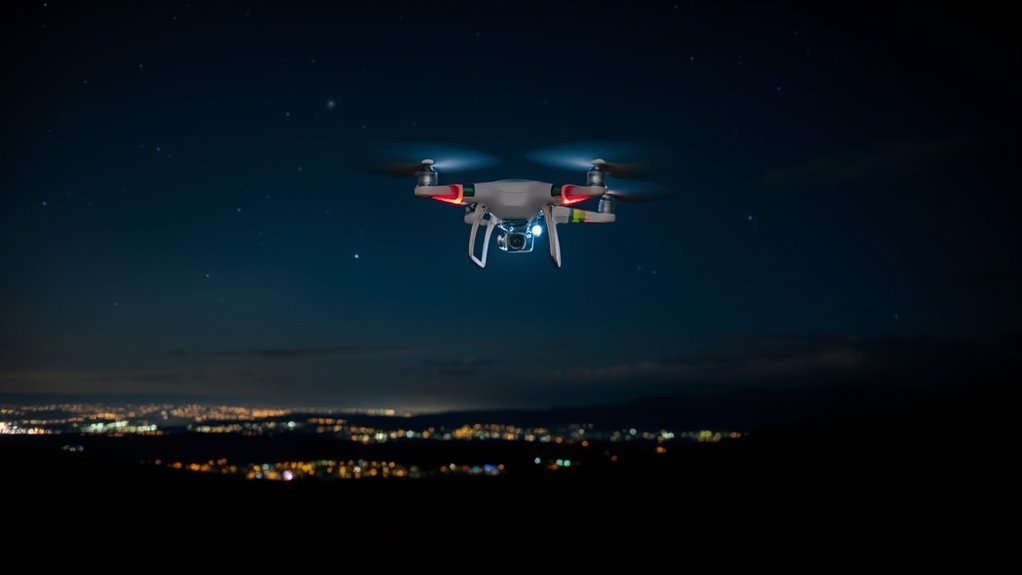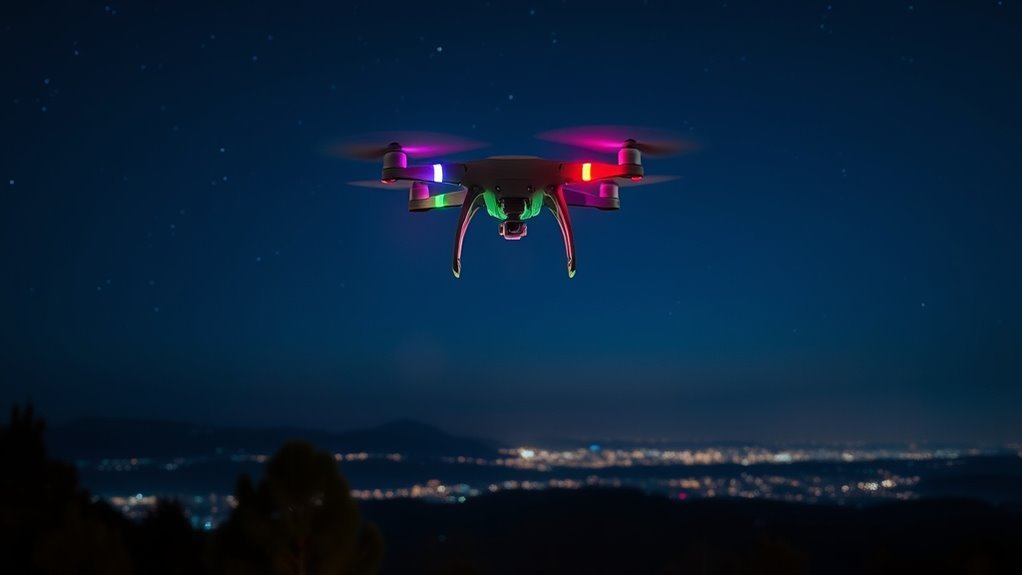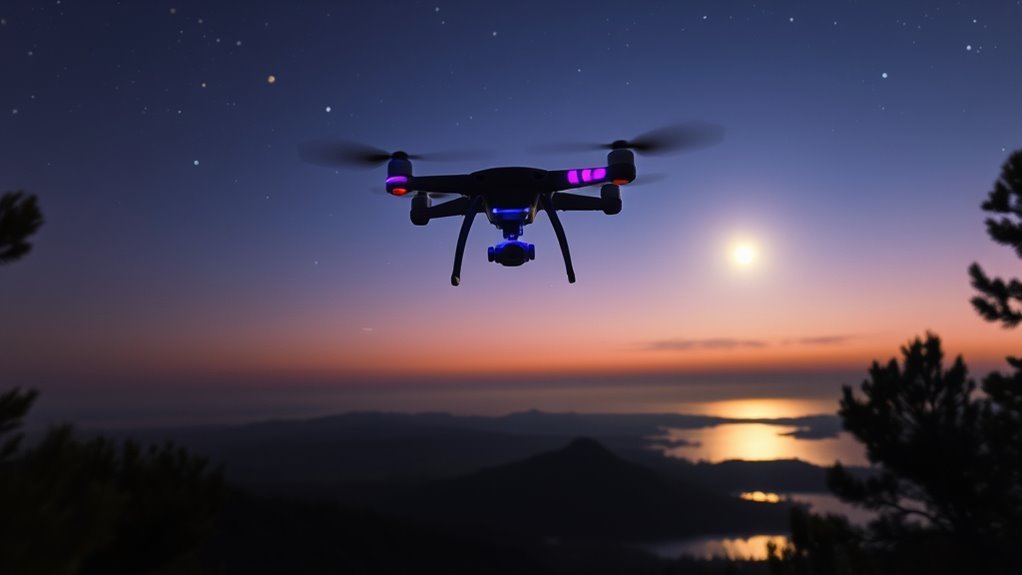To legally fly your drone at night, you need to obtain a Part 107 certification from the FAA. Verify your drone has anti-collision lights visible for at least three statute miles, operational from sunset to sunrise. Before flying, conduct a thorough pre-flight checklist, including battery checks and navigation planning. Familiarize yourself with local regulations and airspace restrictions. By following these steps, you can safely enjoy night flying while remaining compliant with laws—there’s more to take into account as you plan your flight.
Understanding the Regulations for Night Flights

When you’re considering flying your drone at night, it’s important to understand the specific regulations that apply. The FAA has established night flight regulations that require you to follow strict safety guidelines to guarantee both your safety and the safety of others. You’ll need to equip your drone with anti-collision lighting visible from a distance, which is essential for nighttime operations. Additionally, maintaining line-of-sight is critical, so make sure you can see your drone at all times. Familiarizing yourself with local laws and airspace restrictions is equally important to avoid potential fines or penalties. By adhering to these drone safety guidelines, you can enjoy the freedom of night flying while remaining compliant with the law.
Obtaining a Part 107 Certification

Obtaining a Part 107 certification is an essential step for anyone looking to operate a drone commercially, especially at night. This certification process involves a few key steps. First, familiarize yourself with the Part 107 overview, which outlines the regulations governing commercial drone use. Next, study the materials provided by the FAA and take practice tests to prepare for the knowledge exam. You’ll need to understand airspace classifications, weather, and operational limitations. Once you’re ready, schedule your test at a designated FAA testing center. After passing, you’ll receive your certification, allowing you to legally fly your drone at night. Remember, this certification not only enhances your credibility but also guarantees that you’re compliant with federal regulations.
Required Equipment for Night Flying

To fly your drone legally at night, you’ll need specific equipment to comply with FAA regulations. First, make certain your drone has proper lighting, including anti-collision lights that are visible for at least three statute miles. These lights must be operational from sunset to sunrise. Additionally, consider investing in night vision drone accessories, which enhance your visibility and control in low-light conditions. While not mandatory, night vision goggles can also help you navigate more effectively, guaranteeing you maintain situational awareness. It’s essential to familiarize yourself with your drone’s capabilities and limitations at night, as well as any local regulations regarding nighttime operations. With the right equipment, you can enjoy the freedom of flying your drone after dark while staying within legal boundaries.
Pre-Flight Checklist for Night Operations
Before you take to the skies at night, it’s essential to run through a detailed pre-flight checklist to guarantee compliance with regulations and safety standards. Making certain your drone is prepared for night operations is key to maintaining drone safety and enjoying your freedom in the skies.
- Confirm night vision capabilities: Ensure your drone has adequate lights for visibility and navigation. Additionally, verify that your drone is equipped with water-resistant features to mitigate risks in case of unexpected weather changes during night flights.
- Check for updated firmware: Make sure your drone’s software is up-to-date for peak performance.
- Inspect battery levels: Verify that your batteries are fully charged to prevent mid-flight interruptions. Additionally, ensure that your drone is equipped with advanced safety features that can detect and mitigate risks during night flights.
Choosing the Right Location for Night Flying
When choosing a location for night flying, you need to guarantee compliance with local regulations that may restrict where you can operate your drone after dark. Additionally, consider the lighting conditions of your chosen area; adequate illumination is essential for safe navigation and preventing accidents. Make certain to scout locations that meet both regulatory and safety standards to enhance your flying experience.
Local Regulations Compliance
Although flying your drone at night can be exhilarating, it’s essential to confirm you comply with local regulations to avoid penalties and guarantee safety. Here are some key points to reflect on:
- Research local drone laws: Different areas have specific rules about night flying. Make sure you understand them.
- Obtain necessary night flight permits: Some jurisdictions require special permits for flying after dark. Check if you need one.
- Choose appropriate locations: Confirm you’re flying in areas that allow night operations, avoiding restricted zones.
Adequate Lighting Conditions
Ensuring adequate lighting conditions is essential for safe night flying. Choose locations where light intensity is sufficient to enhance your night vision. Urban areas often provide ample artificial lighting, making them ideal for flying your drone at night. Avoid poorly lit spaces, as they can greatly hinder your ability to navigate and control your drone effectively.
Before takeoff, assess the brightness of your surroundings and be mindful of potential obstacles. Areas with contrasting light levels can also affect your perception, so aim for balanced lighting. Always comply with FAA regulations regarding drone visibility, ensuring your drone has appropriate lights installed. By carefully selecting your flying location, you can maximize safety and enjoy the freedom of flying at night.
Tips for Safe Night Flying
When flying your drone at night, guarantee you meet all proper lighting requirements to maintain visibility and safety. Conduct thorough pre-flight safety checks to verify that your equipment is functioning correctly and to avoid potential hazards. Additionally, be aware that federal laws regulate drone operation, which includes specific guidelines for nighttime flying. Finally, stay aware of your surroundings and use navigation aids to prevent collisions and guarantee compliance with regulations. Additionally, ensure you understand federal aviation regulations to operate your drone legally and safely during nighttime flights.
Proper Lighting Requirements
To safely operate your drone at night, it’s essential to adhere to specific lighting requirements mandated by the Federal Aviation Administration (FAA). Proper lighting guarantees nighttime visibility and enhances safety, allowing you to navigate effectively. Here are key points to keep in mind:
- Anti-Collision Lights: Your drone must have lights that are visible from all directions.
- Color Requirements: Use red and green lights to indicate the drone’s orientation.
- Brightness Standards: Confirm your lighting technology meets minimum brightness levels for maximum visibility.
Pre-Flight Safety Checks
Before you take to the night skies, conducting a thorough pre-flight safety check is essential for guaranteeing a safe drone operation. Start with drone maintenance; inspect the propellers for any damage and verify they’re securely attached. Check the battery levels, confirming that they’re fully charged and properly connected. Next, perform an equipment inspection, examining the lights and cameras for proper functionality. Confirm your drone’s firmware is up to date, as this can impact performance and safety. Verify that your remote controller is working correctly and maintain a clear line of sight to your drone. By prioritizing these checks, you can fly confidently and enjoy the freedom of traversing the night sky while minimizing risks.
Navigation and Awareness
Although flying your drone at night can be exhilarating, it demands heightened navigation skills and situational awareness to guarantee safety. You need to stay vigilant and prepared to handle the unique challenges of nighttime navigation. Here are key tips to enhance your flying experience:
- Use High-Quality Lights: Equip your drone with bright LED lights to improve visibility and help you maintain orientation.
- Plan Your Flight Path: Familiarize yourself with the area beforehand, ensuring you know potential obstacles and no-fly zones.
- Stay Aware of Weather Conditions: Monitor weather changes that could affect your flight, especially visibility and wind conditions.
Enhancing Visibility With Lighting Options
Effective lighting options are essential for ensuring your drone remains visible during nighttime operations. To enhance drone visibility, consider using LED lights and strobe beacons. These options provide high light intensity and can be lightweight, helping to maintain your drone’s battery life. Pay attention to lighting placement; mounting lights at strategic points can illuminate your flight path effectively. Also, choose the right color temperature—cool white lights are often most visible against dark backgrounds. If you plan to operate in low-light conditions, incorporating night vision technology can further enhance safety. Remember, proper lighting not only keeps your drone visible but also helps you comply with regulations, ensuring a safe and enjoyable flying experience.
Reporting and Compliance Post-Flight
Once you’ve landed your drone after a night flight, it’s vital to adhere to reporting and compliance requirements to confirm you’re operating within legal boundaries. Proper post-flight documentation is significant for maintaining your flying privileges. Be sure to keep accurate flight logs that detail your operation. Here are three key actions to take:
- Document flight times, locations, and any incidents during the flight.
- Verify your logs align with FAA regulations to avoid potential fines.
- Submit any required reports to your local aviation authority if applicable.
Following these steps not only keeps you compliant but also enhances your credibility as a responsible drone operator. Freedom in flying depends on your diligence in documentation and adherence to regulations.
Frequently Asked Questions
Can I Fly My Drone at Night Without a Part 107 Certification?
Did you know over 70% of drone accidents happen at night? Without a Part 107 certification, you can’t legally fly your drone after dark due to regulations concerning drone safety and night visibility.
Are There Any State-Specific Regulations for Night Drone Flying?
Yes, there are state laws that impose specific night regulations for drone flying. You’ll need to check your state’s laws to guarantee compliance, as they can vary considerably and impact your night flying freedom.
What Is the Maximum Altitude for Night Drone Flights?
When the stars twinkle above, you might wonder about night flight restrictions. For drones, altitude limits cap at 400 feet. Staying within boundaries guarantees your freedom soars, while keeping the skies safe for everyone.
Can I Use My Drone for Commercial Purposes at Night?
Yes, you can use your drone for commercial purposes at night, but you’ll need to meet specific night flight requirements, including proper lighting and certification, to guarantee compliance with regulations governing commercial drone applications.
How Do I Report an Incident Involving My Night Drone Flight?
To report an incident involving your night drone flight, guarantee you document the details thoroughly, following safety protocols. Submit your findings to the relevant authorities, emphasizing transparency and adherence to regulations for future safety and accountability.

